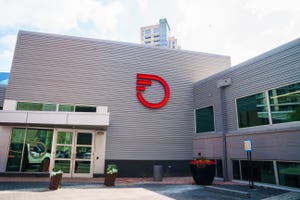The long-distance view of OFC: 800G and more!
Move over, 5G – we're talking 800G! As the OFC show continues, albeit minus a few big names, the optical transport sector fills the Light Reading inbox with news of technical advances and deals galore.
March 11, 2020

Despite pre-show concerns about you know what, the annual OFC event is underway in San Diego, but, like a few other companies, the Light Reading team isn't there this year.
So we don't have any reports from the show floor, conference rooms and San Diego's cheapest bars, which is a shame because the optical transport gear sector had a good year in 2019, growing by 6% in 2019, according to the team at Dell'Oro, and we could have celebrated its success with a tequila or six.
Figure 1: Just look at that sunny sky... 
Many trends and topics are being discussed at the show this week, but 800G optical transport was always going to be near the top of the list. Check out this analyst note by Ian Redpath, who leads Omdia's Optical Networks, Optical Components and Core Switching practice, to find out how advances in coherent digital signal processing are enabling 800G and impacting the optical transport market.
So, kicking off with some 800G announcements, here's a run-down of the recent main announcements of note from the optical and IP transport sector's key players.
Ciena, which last week reported a 7% year-on-year increase in revenues for its fiscal first quarter, has been banging the drum about its single-wavelength 800G and 600G engagements of late, with Verizon and Comcast the two big network operator names that have been checking out the vendor's wares. (See Comcast, Ciena connect on 600G link, Test shows Verizon's fiber network can move 800 Gbit/s of data on a single wavelength and Ciena reports sales hike in fiscal Q1 .)
Ciena is also pumped about its 400 Gigabit Ethernet interop test with Arista, involving the former's Waveserver 5 interconnect platform, powered by Ciena's WaveLogic 5 Extreme (WL5e) coherent optics, and Arista's 7280DR3 router. The full details are in the duo's press release, but it's fair to say this looks appealing for network operators of all kinds looking to take their data center interconnect (DCI) links to the next level. (See Ciena, Arista proud of 400GE interop test .)
800G is also front and center for Huawei, which conducted trials with Turkcell and China Mobile on the operators' live transport networks. The Chinese vendor also recently unveiled OptiXtreme H7, an 800G tunable optical module based on technology developed by its own component subsidiary, HiSilicon. (See Turkcell and Huawei complete the world's leading 800G trial on the live carrier network, Huawei's Ding gives open RAN short shrift, updates on supply chain and China Mobile Zhejiang and Huawei Complete 800G Optical Transport Trial on Live Networks.)
Infinera is also a member of that particular technology club: It is shouting about how it has enabled an 800G single wavelength over 800km using its ICE6 technology, a digital coherent module announced in mid-February, and Corning's TXF fiber. Infinera recently reported a strong end to 2019, with its fourth quarter revenues up by 15% year-on-year to $387 million. (See Infinera, Corning deliver 800G single wavelength and Infinera reports Q4, full-year sales growth.)
Inphi says it's sampling its new Spica 800G 7nm PAM4 DSP, which it claims is the first 800Gbit/s (or 8x100Gbit/s) PAM4 DSP to enable 800G optical transceiver modules in QSFP-DD800 or OSFP form factors. Try and prove them wrong! For more details, see this detailed press release.
Nokia hasn't been banging on about technology advances so much but would have been talking in San Diego about how Rakuten Mobile, the greenfield Japanese operator, has deployed its 1830 PSS (Photonic Service Switch) in a nationwide optical mesh network linking its metro aggregation and data center sites. (See Rakuten Mobile to use an optical mesh network for backhaul.)
ECI Telecom, meanwhile, is now no longer an independent entity, with Ribbon Communications having completed its acquisition of the Israeli vendor. So it is Ribbon-ECI (get used to it, people…) that has launched 400 Gigabit Ethernet (400GbE) muxponders (multiplexing transponders) designed for the vendor's Apollo optical transport system. For more details, see this press release.
Intel says it has "successfully integrated its 1.6 Tbit.s silicon photonics engine with its 12.8 Tbit/s programmable Ethernet switch." That's a lot of horsepower. "This co-packaged solution brings together the essential technology building blocks from Intel and its Barefoot Networks Division for integrated optics on an Ethernet switch." Large data center operators are the ones set to get most excited here. For more details, see this Intel news announcement.
While 800G might be a major talking point, the current ramp in demand for the components companies is in 400G. Acacia, which is in the process of being acquired by Cisco and which recently reported a near 37% leap in full year revenues, says it's now sampling multiple variants of its 400G pluggable transceiver modules that are suitable for multiple network operator applications including, of course, data center interconnect. (See Acacia offers range of 400G modules.)
II-VI, which last year completed the $3 billion acquisition of Finisar, has been busy this week, announcing what it claims to be the first pluggable optical line subsystem platform for 400ZR coherent transceivers for the DCI market. It also unveiled the 400G CFP2-DCO, a module "to support high-performance 400 Gbit/s coherent transmission in a pluggable form factor," and a 64 Gbaud integrated coherent transmitter-receiver optical subassembly (IC-TROSA) for 400ZR DCI deployments. For more on what II-VI is up to, check out its media center.
ProLabs, the developer of third party optical components, has launched a new transceiver, the QSFP28-DD 2x 100G, which has been designed to help network operators to "increase port-density, solve interoperability issues between current and future infrastructure, and minimize infrastructure investments." For more details, see this press release.
Also of interest:
— Ray Le Maistre, Editor-in-Chief, Light Reading
You May Also Like










